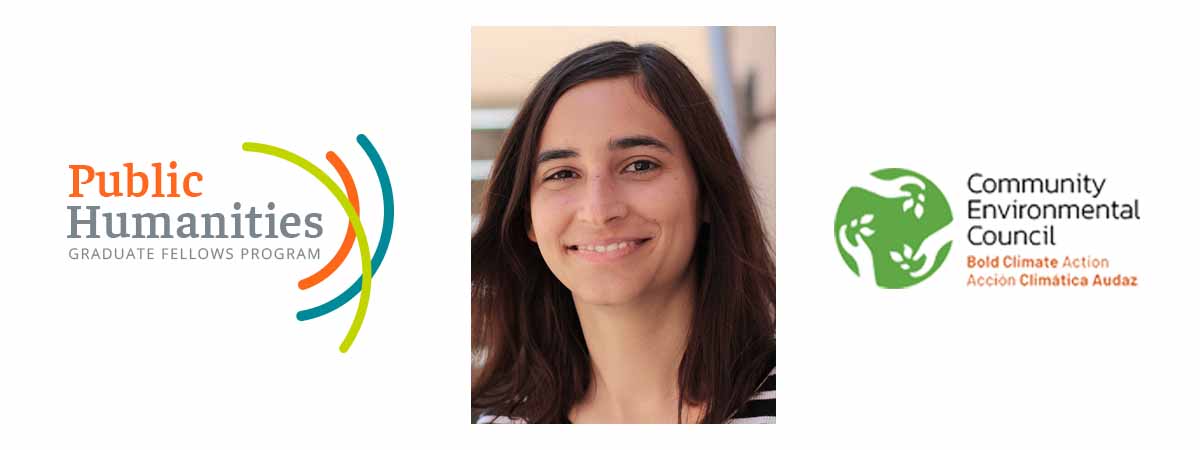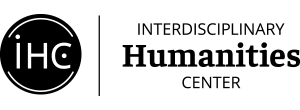
10 Sep Interview with Maria Zazzarino on working with the Community Environmental Council
September 10, 2024
Maria Zazzarino is a Ph.D. student in the Department of Comparative Literature, where she works on Latin American and Caribbean literatures with a focus on environmental aesthetics. As an IHC Public Humanities Graduate Fellow, Zazzarino worked with the Community Environmental Council as their External Communications Fellow.
What were your primary tasks as External Communications Fellow?
During my internship, I assisted the Community Environmental Council in conceptualizing and planning the Climate Arts Project. This initiative seeks to engage community members in environmental questions through the arts. When I began my internship in the summer of 2023, the CEC was about to open the Environmental Hub, a large space located on Santa Barbara’s State Street, very close to the city’s arts district. The idea was to develop a concept and initial plan that would allow this space to house initiatives to engage the CEC community through the intersection between art and environmental questions. More broadly, my task was to help the CEC research and design an arts project for this setting in order to expand their mission to reimagine how we inhabit the planet through a climate justice perspective.
My tasks included several initiatives to create a fair process for the arts project. I designed a survey to consult different internal stakeholders (board members, staff, and allies) to determine what the goals of the project should be, what kinds of programming should be included, and who should be included in the project’s decision-making. I examined and organized the survey responses and researched and analyzed best practices of similar projects in California and the US. I used this information to draft mission and vision statements.
The purpose of these activities was to develop a clear concept for the project and then to invite arts enthusiasts and allies to serve on the project’s Advisory Committee. Establishing the Committee became the main deliverable during the second half of my fellowship period. The committee included members from prominent art institutions in the Santa Barbara, Ventura, and San Luis Obispo Counties, including the Santa Barbara Museum of Art, the Santa Barbara Museum of Contemporary Art, the Music Academy of the West, the San Luis Obispo Museum of Art, and other artistic community members. During this phase, my tasks included drafting letters of invitation and managing calls for applications, as well as contributing to the planning of the first committee meeting in December 2023.
Throughout my fellowship period, I also developed a series of resources for CEC team members. I built a guide that compiled important resources in the Central Coast, including grant opportunities, potential partners, environmental artists, and UCSB faculty who work on environmental arts. In addition, the guide included materials that could be helpful when designing community-oriented environmental arts projects. In the process, I learned about the organization Americans for the Arts, which publishes very valuable resources and reports that I am sure I will continue to consult in the future.
What experiences during the internship were most impactful for you?
One of the most interesting parts of the internship was participating in project planning. Most of my tasks involved ensuring that the project was developed following fair and just practices that would consider CEC board members and staff. In the context of this organization, this meant formally consulting CEC’s staff and stakeholders in the development of the program’s mission and potential programing. Although I was familiar with fairness, justice, and inclusivity as guiding principles for public-serving projects, I had never seen collective decision-making in practice, especially in such a large organization. This was a lesson in good leadership and mission focus, ensuring that we served the institution and not just the preferences of specific project managers and organizers.
Additionally, I learned about the different initial stages of project planning, such as writing concept statements, putting together teams of people, analyzing comparable initiatives, and assessing your own resources, as well as taking the time to think very carefully about what it is that you are hoping to implement. I was able to participate in these processes as the organization itself was trying to figure out these questions. It was rewarding to observe different thought processes in the context of a nonprofit.
How did your graduate training prepare you for this work?
My research skills were incredibly helpful in performing my tasks. The aims and themes of the Climate Arts Project are very well aligned with my own research in the environmental humanities, a field that, among many other questions, asks what do questions of representation and storytelling have to do with the environment? To an extent, this was one of the questions that held the Climate Arts Project together.
However, this is only one of the ways in which I could transfer skills learned in graduate school to a non-profit setting. My research skills were also incredibly helpful for survey design. I drew on these skills to craft meaningful questions, analyze responses, and synthesize main points that would inform the project’s mission and vision statements. They were also useful when researching the strategies, materials, and best practices of similar projects elsewhere. This helped me to identify areas of opportunity for the CEC to utilize its unique resources and position. In a way, the process was not dissimilar from what we do as graduate students when drafting our research proposals: we need to identify something we can achieve with our resources and make our own unique contributions in a given area of intervention.
The IHC’s Public Humanities courses also prepared me for practical tasks that are not commonly part of a Humanities academic curriculum. Verbal and communication styles vary widely in both settings, and the communication skills that I learned throughout the Public Humanities Graduate Fellows Program were invaluable. In addition to concrete skills, these classes helped me to develop an attitude based on careful listening to really understand the strategic needs and goals of the organization and an enthusiasm to do my best to help achieve them.
What are your new skills?
I gained valuable practical knowledge by taking on tasks that I had never had the chance to put into practice before. I learned to design surveys so that responses would be helpful and to be careful not to overdetermine the responses. I also learned multiple writing genres that were previously unfamiliar to me, such as the concept statement and the best practices report. These are very succinct formats with their own conventions, purposes, and efficacies that I was unfamiliar with and that I became aware of through practice and feedback. In one instance, I received a comment that “this is not a phrase the CEC would use,” which made me realize that I was no longer writing for myself or for what an academic audience might expect but as the collective voice of an organization with its own audience expectations that need to be honored.
This seemingly minute comment illustrates the more general takeaways from this experience. All my tasks involved both thinking about the organization’s needs and language and helping it communicate with others that the organization sought to affiliate or collaborate with. In the process of configuring the advisory committee—from stakeholder consultation to our first meeting—I realized that multilateral conversations often involve some degree of translation or mediation. The Climate Arts Project entailed bringing together an environmental organization and local arts institutions with shared goals, but sometimes, the language that each of these stakeholders speaks or the way in which they envision their purpose might be different. Understanding different languages and positions and where they might converge—being aware of these differences and working through them—is one of the lessons that I took from my internship. This is also related to developing a different kind of positionality or sensibility that moves beyond what we as individual scholars or experts-in-training might think “should be” to allow the space needed for truly collective decision-making.
What did you enjoy the most?
As an international student whose graduate school experience has been significantly marked by social distancing—which limited opportunities to connect and get a sense of the community that was hosting me—this internship was an incredible opportunity to get to know and collaborate with community members immersed in creative endeavors. It also allowed me to better understand both environmental activists as well as arts organizations in the region. Learning about how to conceptualize potential projects in conversation with others has been one of the highlights for me.
In addition, I enjoyed researching community arts and participatory environmental arts initiatives across the US as well as reading about and distilling best practices of similar projects. As I was thinking about the CEC’s resources and their own mission, it was very inspiring to learn about the many transformative initiatives that are already underway and so many exciting possibilities yet to be developed as well. The experience really got me thinking about different models of community engagement that I could potentially initiate with my own skills in the future.
How might this experience inform your remaining graduate or post-graduate career?
If there is one thing that my internship at the CEC and the Public Humanities Program more broadly have provided me with, it is an amplification of possibilities. Part of the development of the Climate Arts Project had to do with reframing a certain kind of storytelling: what environmental horizons, relationships, and experiences look like from our regional perspective. As a literary scholar, it has allowed me to consider multiple modes of storytelling that might be overlooked within the parameters of our more traditional canons and to rethink other kinds of meaningful storytelling that could make it into a literary research project or curriculum.
I should mention here that I started the Public Humanities program during my first year in graduate school, so even if these questions became more tangible with practical experience, they have accompanied me throughout my training as a researcher and educator. I mentioned earlier that I have come to understand the Public Humanities as a certain kind of disposition or sensibility, and ever since those initial courses, I have thought about how to incorporate this approach not only in research but also in the classroom. For example, in “Storytelling in the Anthropocene,” my first self-designed course at UCSB, I experimented with environmental justice methods, modes of mapping, and storytelling that would allow students to tell their own environmental stories and think about their own emplacements. Although I was not quite sure what the result would be, this has been one of the most well-received activities that I have developed in a class and its end result turned out to be a collective environmental atlas that students could consult and disseminate. I am still thinking about how to incorporate similar initiatives in other classes that might not readily lend themselves to these kinds of pedagogy. There is still a lot of room for experimentation as I continue how to figure out the possible crossovers between the traditional classroom and public-oriented questions.
I am now nearing the completion of my graduate degree, so, like most of my colleagues, thinking about the future is part of my everyday. If I do find an academic position, what kind of scholar do I want to be and what skills do I want to offer my future students? If I do not, how can I use my skills in order to still contribute to the questions that I am committed to? From my experience during the Public Humanities Program as well as during the research I carried out during my internship at the CEC, I have learned that there is more than one possible path for those of us who are trained in the Humanities: non-profit work, accessible popular education, community-oriented storytelling activities. Whatever direction my future takes, I am certain that I would like to develop or incorporate some of these initiatives.
Click here to learn more about the IHC Public Humanities Graduate Fellows Program.

